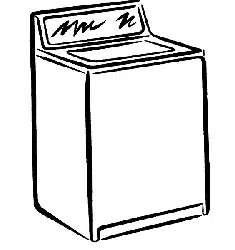Loading ...
Loading ...
Loading ...

Adjustable END OF CYCLE SIGNAL
A tone will sound at the end of the cycle. The sound level of this
tone can be adjusted by pressing END OF CYCLE SIGNAL. The
volume of tone you will hear at the end of the cycle will sound as
the pads are pressed.
_HIQH
LOW
_Ol_i;
Ehll OF OYQL£
511111L
Indicator Lights
SELECT CYCLE
Located next to each pad, these lights show the cycle you have
selected.
OPTIONS
These lights show the Prewash and/or Rinse/Spin Options you
have selected.
MODIFIERS
These lights show the selected Wash/Rinse Temperature, Wash
Time, Estimated Time Remaining in cycle, and End of Cycle Signal.
WASHER STATUS
These lights show what portion of the cycle the washer is operating.
_t<_,sAi Iil \(7
_I_AiiO I! liFi
_ Cl()}Iii{! ( i i!AI_
Operating Controls
START
Press START to start your washer after a cycle has been
selected. Be sure all desired Options and Modifiers have been
selected. The lid must be closed for the washer to start.
STOP/CANCEL
Press STOP/CANCEL once to pause or stop the washer at any
time. Press START to complete the cycle from where it was
stopped. Press STOP/CANCEL twice to turn off the washer.
LAUNDRY TIPS
Preparing clothes for washing
Follow these recommendations to help you prolong the life of
your garments.
• Always use HE detergent detergents. The package for this
type of detergent will be marked "HE" or "High Efficiency."
The new wash action of the CALYPSO _ system, along with
less water, will create too much sudsing with a regular
non-HE detergent. Using regular detergent will likely result in
washer errors, longer cycle times, reduced rinsing
performance, and may result in component failures and
noticeable mold or mildew. HE detergents such as TIDEc_HE
are made to produce the right amount of suds for the best
performance. Follow the manufacturer's instructions to
determine the amount of detergent to use.
• Shake out sand, dirt, and other matter before placing clothes
and other items into the washer. Doing so will increase the
performance of this low-water washer.
• Close zippers, snaps, and hooks to avoid snagging other
items. Remove pins, buckles, and other hard objects to avoid
scratching the washer interior. Remove non-washable trim
and ornaments.
• Empty pockets and turn them inside-out.
• Turn down cuffs; brush away lint and dirt.
• Turn synthetic knits inside-out to avoid pilling.
• Tie strings and sashes so they win not tangle.
• Mend tears, loose hems, and seams.
• Treat spots and stains.
• Stained or wet garments should be washed promptly for best
results.
Sorting
• Separate heavily soiled items from lightly soiled ones, even if
they would normally be washed together. Separate lint-givers
(towels, chenille)from lint-takers (corduroy, synthetics,
permanent press). When possible, turn lint-givers inside-out.
• Separate dark colors from light colors, colorfast items from
noncolorfast items.
• Sort by fabric and construction (sturdy cottons, knits, delicate
items).
Loading
• Drop clothes in; don't wrap.
• Small garments go first. Do not put small items on top.
• Use mesh garment bags to wash undergarments such as
underwire bras, items with strings, and small items such as
socks.
Unloading
• Remove clothes from washer after the cycle is completed.
Metal objects such as zippers, snaps, and buckles may rust if
left in the washer basket for a long time.
Loading suggestions (maximum size loads)
KING SIZE TM Capacity Plus Washer
Heavy Work Clothes
4 jeans 2 sweatpants
4 workpants 2 sweatshirts
4 workshirts
Towels
10 bath towels
10 hand towels
14 washcloths
Mixed Load
3 sheets (1 king, 2 twin) 9 T-shirts
4 pillowcases 9 shorts
3 shirts 10 handkerchiefs
3 blouses
16
Loading ...
Loading ...
Loading ...
